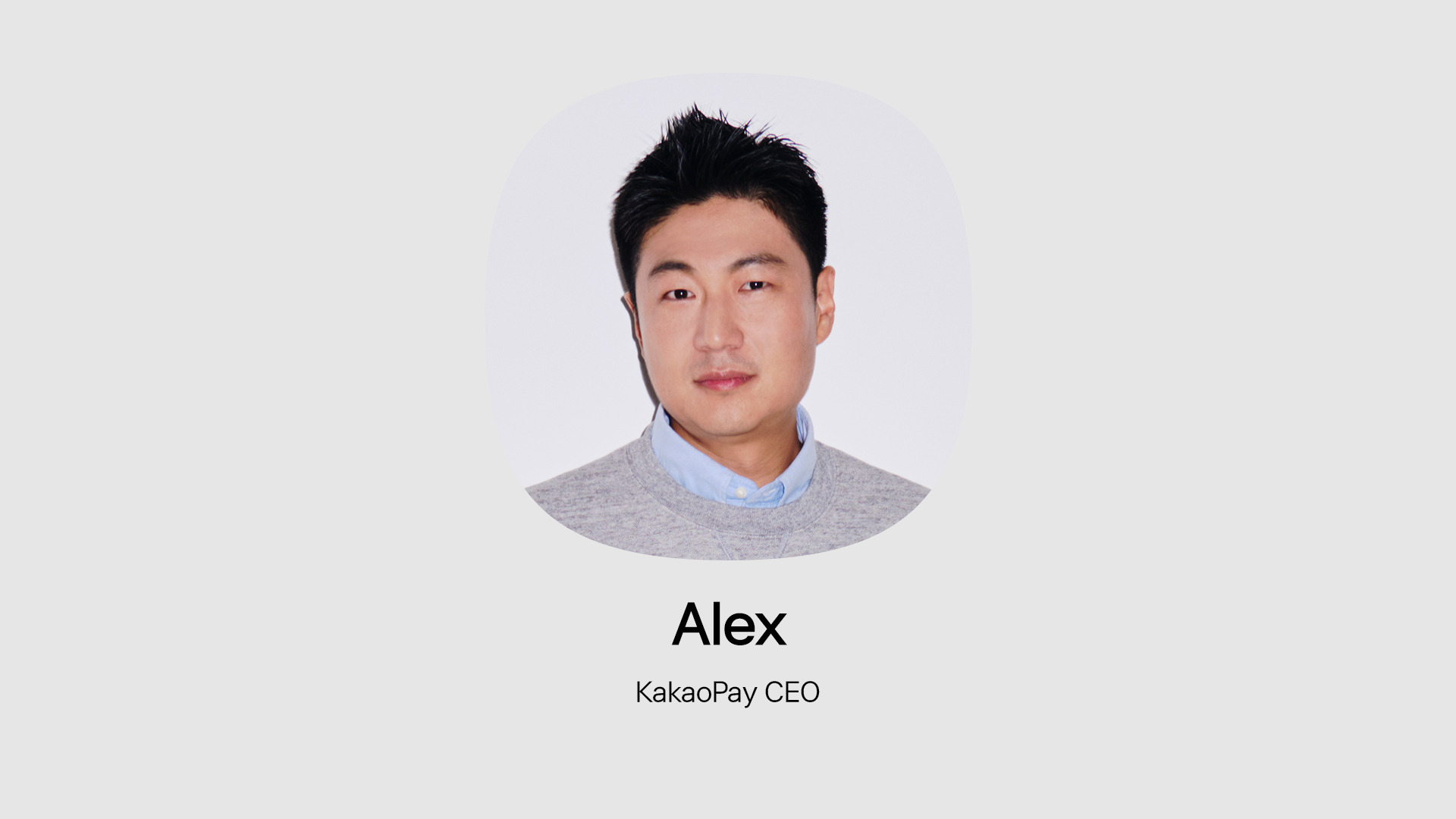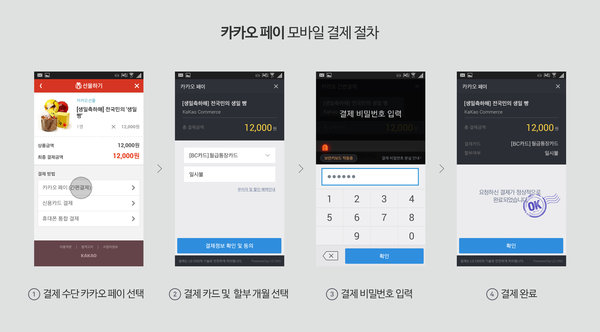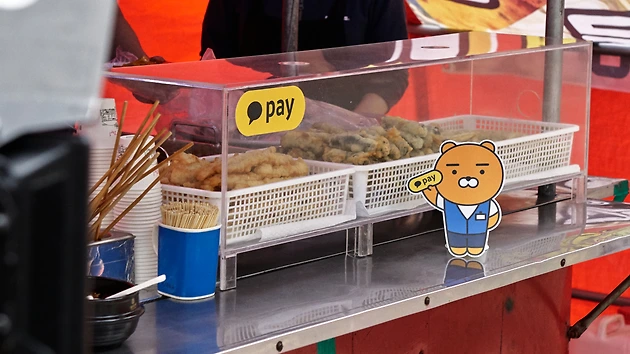So much has changed in seven years
There are so many 'no-nos' in the financial business since it handles the transaction of valuable assets. That's why we often encounter layers of precautions to prevent a financial incident that may occur by any possibility. However, there appeared a service raising a question on whether or not to just look at changing environments even after everyday life had been completely rebuilt around the mobile device. KakaoPay came up that way.
'Why should we go through as many as eighteen steps to buy a product on mobile?' This simple question, raised in early 2014, gradually generated the Snowball Effect and eventually gave shape to the current KakaoPay. KakaoPay, starting as an easy payment service, has presented practical examples in various areas such as money transfer, prepaid card, membership connection, billing, investment, and insurance. For instance, KakaoPay users who shared lunch can divide and make payments in seconds on KakaoTalk. Also, KakaoPay enables its users to invest petty coins remaining after payment into various financial products.
We visited the KakaoPay office on December 10, 2020, when the Amendment to the Electronic Signing Act abolishing over a 20-year-long monopoly status of Accredited Certificate took effect. KakaoPay is the first trailblazer that launched a payment service with fast identity online (FIDO) authentication. As luck would have it on that day, KRW 100 billion was collected in its fund in 10months after KakaoPay Securities started to conduct business and sell funds. We interviewed Alex, the CEO of KakaoPay, on how the company began and walked the road to innovation.
# The first step is always the hardest.
Alex, who joined KakaoTalk as a developer, requested for the transition of job group after the launch of free calling service, Kakao's mVoIP (mobile voice over Internet protocol) service. He used to live as a developer from undergraduate and graduate to office years. Therefore, he wanted to experience drawing up and materializing business firsthand from an inventive mind to design fundamental changes from alpha to omega.

The company appointed him to New Business Development Team in Commerce Division, which was then pondering on 'Next Something' after ever-growing KakaoTalk Gifts that caused a fresh sensation. However, on the hidden side of the service growing like a weed in the sun, lay payment errors of nearly 50 percent. In the second half of 2012, users had to endure eighteen screen changes to buy just one item on mobile. Kakao paid attention to this inconvenience and organized a small TF team to find a solution such as FIDO-based payment and minimum screen changes.

The TF team analyzed that the company could extend its business field to large-scale financial services such as loans and insurance if successfully collecting users by improving the convenience of frequently-used payment methods. It was like treating payment or remittance as Internet 'traffic,' which starkly contrasted with business priorities among conventional financial institutions. Kakao could come up with such an idea because it was an Internet-based startup born on mobile.
Where it should head for was crystal clear, but how it could get there was excruciatingly difficult. Kakao already lacked developers who could deal with KakaoTalk, Gifts, KakaoStory, KakaoGames, and other existing services. 'What kind of external solutions should be embedded?' 'How can we convince relevant authorities and financial institutions to join our project?' As such, many challenges were just ahead. To speed up the development, Kakao decided to implement the service utilizing external solutions for the moment.
However, apart from facilitating the service development, it took as long as 15 months to convince credit card companies to join the project. Persuading Krews was another serious undertaking since dissent was strong inside for planting financial business in the ground of KakaoTalk. The thing is that KakaoTalk was heavily checked by the vest interests, so its expansion into banking sectors would only result in many pangs. Alex, who had prepared for the launch of mobile payment service, and Eljay (currently the Head of KakaoPay Payment Business Clan), who had just entered the company as career staff, sat face-to-face at a hamburger stand near the office to discuss what they should do to catch momentum. They reached an agreement: 'If we fail to launch mobile payment service at Kakao, we should leave the company and start our own business.'
From the next day, Alex met with decision-makers, one by one, and tried to convince them. A few days later, a 'focus table' meeting was held to discuss the feasibility of the business together with Chairman, CEO, and business managers. After a deep and intense discussion, they came to a conclusion, "Let's give it a shot." It took one and half years to get everyone on the same page. In mid-February 2014, Kakao finally organized its Payment Division composed of three members.
#Even if you twist the first cock's neck, the dawn still comes
From Alex's memory, around this same time, he made "frequent visits to eight credit card companies and financial authorities until their thresholds wore out." It was not anything but easy to arrange a meeting with managers at credit card companies since they considered Kakao as their contender or invader, not a potential partner. In the meantime, financial authorities, which should regulate and support the financial industry based on laws enacted before the mobile era, was at a loss since they did not know what standards they should apply.
Amid twists and turns, the Payment Division recruited designers and developers to become an organization of about ten members. And one day before the service launch, many credit card companies that had agreed to partner with Kakao notified a sudden absence. One service planner became emotional and burst in crying in front of colleagues.
"The clues are all there on mobile. We will go with KakaoPay as planned." Those words from one credit card company's manager that they would never reverse their decision 'despite the panic about the uncertainty' were still ringing in his ears.
On September 5, 2014, KakaoPay was launched for the Android OS, only with the Easy Payment function included. Some underestimated it as a half-baked service due to the absence of the majority of credit card companies. Others predicted that KakaoPay would usher in the wallet-less era. Stock market indicators responding shrewdly gave an idea of KakaoPay's growth potential: Share prices of Payment Gateway operators plummeted.


Then, unexpected variables arose while Krews were conceiving and preparing the business. Kakao and Daum Communications announced that they would merge to form an IT giant. That means, KakaoPay would be the first service provided by Kakao after the merger announcement, so expectations inside the company were as high as possible. Then came out criticism as to whether it was worth calling the service that many credit card companies refused to join as the 'universal payment.' It took another two years for all the card companies that had noticed their absence to participate again.
In the meantime, several Internet platform operators and credit card companies launched '~pay'-like easy payment or app card services. As of 2015, the number of such services even exceeded 30. And it took two years to cooperate with commercial banks for mobile transfer service while contacting one by one.
Alex told us about what spurred KakaoPay to tread firmly and unweariedly into this vexed arena for a long time.
"I have envisioned the current business structure and shape from the time of service launch. Its business structure should inevitably bear the deficit due to the initial focus on gathering as many users as possible, which existing financial companies did not take seriously into account. KakaoPay presents fresh and easy convenience one after another, and many other companies follow its step. Kakao understands and paintains such a business structure. In contrast, others must achieve results within the current CEO term, but we didn't. That's why we were able to move consistently and patiently."
#Strategic patience
KakaoPay's businesses started where they could reduce or eliminate users' inconvenience. They seemed little and insignificant outwardly, behind which complex interests should be streamlined or eliminated.
That's why it required KakaoPay to pour 3~4 years of time and effort in internalizing its remittance business previously serviced as an independent 'Bank Wallet Kakao,' and its easy payment system utilizing external solutions.
It is now taken for granted to make free money transfers with mobile account balances, but there was no legal basis for realizing such an idea at the time. Kakao thus collaborated with commercial banks to provide a free remittance service for enhancing user value, but on the other side, it had to bear discounted price compared to the previous remittance fee as its own expense. In fact, it took another two years to terminate the Bank Wallet Kakao service and connect all commercial banks to KakaoPay. As for the Easy Payment service, KakaoPay showed a different extent of sympathy from its partners in terms of service improvement speed. KakaoPay was changing slowly and little by little on the surface but paddling hard underneath.
Alex looked for external investors since 2015, the year after the service launch. This was because if KakaoPay remained only as an in-house business unit, it would not be easy, from his judgment, to become a priority among various Kakao services. For one year after its launch, KakaoPay collected about five million users, and it was also a time when all eyes from inside and outside were on so-called 'national services' that retained tens of millions of users.
Financial investors responded that it would be difficult to speed up business development for various reasons such as regulations, collaboration structures, etc. At the time, one strategic investor responded that KakaoPay was worth tolerating massive and long-term investment.
It was Ant Financial Services Group (Alipay) that spun off from Alibaba Group. Also, Alipay and KakaoPay had the same orientation as the 'Financial Life Platform.' After a year of coordination, KakaoPay attracted an investment of 200 million dollars in February 2017 and became a separate company from Kakao on April 3, 2017, as determined by the board of directors in January of the year.
#J-curve growth
The Payment Division began with three members and increased to sixty at the time of the spin-off. There were more than 700 as of late 2020. Alex picked up the spin-off as the most decisive moment while looking back over the past six years of KakaoPay. That's because KakaoPay has now regained the No.1 position for the indicators once overtaken by competitors, owing to a quick decision-making system after becoming an independent company.
Its business area has also expanded under a consistent context, where it creates something that was what users 'wanted to exist' but unable to realize due to institutional limitations or restraints by vested interests in the industry; it realized a FIDO-based world; it acquired a securities company to secure a license for the financial work and launch various fund products such as Egg Investment or Petty Coin Investment; and it created a loan comparison service emancipating users from the typical drudgery of taking half a day off and becoming 'Eul,' a pejorative term for the underdog in Korean, in front of bank window. At first, it seemed like 'another kind,' but it is now in line with the background of the birth of FIDO payment and financial services as well as fee-free remittance service that have become the standards.
In the area of P2P investment and loans, KakaoPay is pursuing "medium risk - medium return," as well as fundamental differentiation reducing user risk close to zero. In 2021, it plans to diversify loan service types and strengthen 'personalized' insurance products that eliminate unnecessary coverages. Somewhere along the line, almost every financial institutions have joined or plan to join the KakaoPay platform.
As the world was plagued by COVID-19 in 2020, what did KakaoPay lose and gain? Here's Alex's answer.
"Payments drastically decreased in the fields of aviation, duty-free and travel. Offline-payments that we laid the groundwork for in recent years have also shrunk. The index of dutch pay or money transfer also fell as social activities declined. However, delivery and e-commerce have taken their place. Meanwhile, remittance for congratulations and condolences also increased noticeably. It was also positive that there was a new and large influx of middle-aged people who used to be unfamiliar with mobile payments. I think it is because those who had previously felt distant from mobile payments became familiar with the use of Kakao QR check-in (due to the recent pandemic), and they got to adopt KakaoPay's QR method into their daily lives."
Along with the J-curve growth, the expansion of business area seems to hedge major risks.
#Questions and persistent problem-solving
There was a small question at the origin of all these stories: 'Why should we do this?' Innovation is irrigated by mega traffic created by persistently solving this question that conventional players often neglected. Cultivated wasteland becomes fertile farmland where financial institutions can share fruits on one side and users on the other side. There exist novel values created behind a tiny app icon on a handspan-long smartphone.
Alex said, "A service should make us earn money, save our time, or entertain us. If one or two of these three goals goes for your item, then it is worth developing." He also added. When a financial authority manager watching KakaoPay challenge since those days when laws and institutions were at odds with a rapidly changing trend of the times said that "a lot changed in seven years," I feel anew such a small question has created significant value. The financial authorities have changed their attitude from preventing incidents to pursuing innovation because such challenges by KakaoPay and many other Tech Fin companies have made values.
"As if everyone installs KakaoTalk on his/her new smartphone, I want to make KakaoPay a cure-all for everyone's financial life." This hope, as did before, is slowly being realized now.
- Life Effortless finance,
Kakao Pay #finance#kakaopay#payment#techfin#transfer
#finance#kakaopay#payment#techfin#transfer - Kakao Tech Accessibility of Kakao Corporate Sites
 #WebAccessibility
#WebAccessibility

